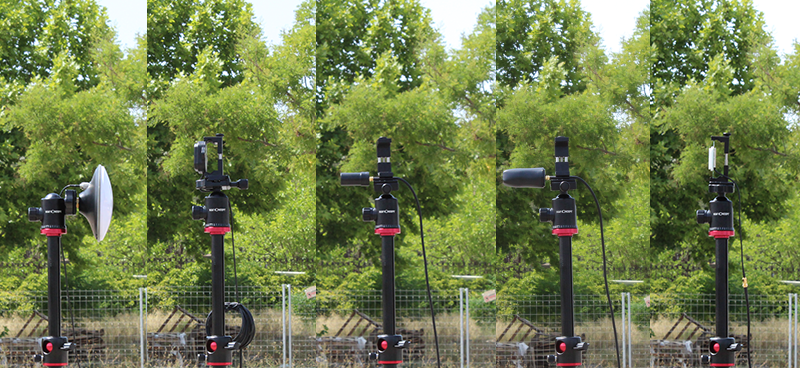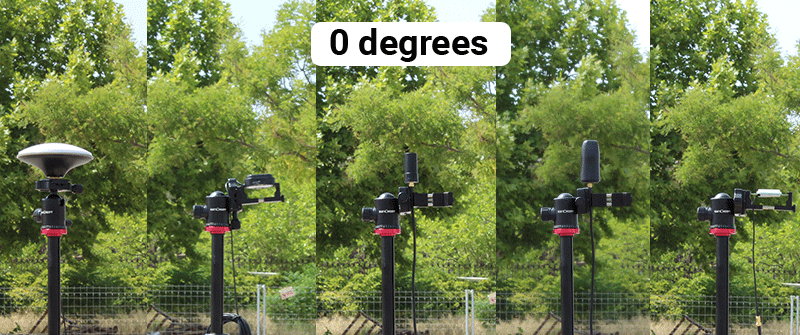RTK GNSS performance with extreme antenna positions


How do weird RTK GNSS antenna positions affect the receiver performance?
We receive many requests asking the above question. The answer is not easy because it depends on many factors that are hard to define precisely.
In this post we tried to do a qualitative analysis to give you an idea on the effects of strange antenna position.
We have analyzed some of our most popular antennas.
Test environment:
- Antennas mounted on a tripod on a near-ideal environment with good view of the sky and no close buildings
- For each antenna we defined three orientations: 0deg (ideal), 45deg and 90deg (see pictures for better understanding)
- For each antenna and position we left the receiver active for 1 minute and we recorded a short 15 second log
- Tests are not done at the same time so satellite geometry between tests is not exactly the same.
All tests where conducted in a 30 minute window. - Receiver used is simpleRTK2
- The receiver was getting VRS corrections from ICGC free NTRIP Caster
Variables analyzed:
- L1cn0 [dBHz]: 10 strongest signals from L1 band are averaged over the log period
- L2cn0 [dBHz]: 10 strongest signals from L2 band are averaged over the log period
- PDOP: Position (3d) Dilution of Precision is averaged over the log period
- numSV [#]: number of satellites used are averaged over the log period
- Hacc [m]: horizontal accuracy (estimated) is averaged over the log period
| Antenna | Position | L1cn0 | L2cn0 | PDOP | numSV | Hacc |
| Helical dual band | 0deg | 47,11 | 45,35 | 1,01 | 30,00 | 0,014 |
| 45deg | 46,63 | 43,80 | 1,01 | 30,00 | 0,014 | |
| 90deg | 44,73 | 42,59 | 1,01 | 29,77 | 0,014 | |
| Helical triple band | 0deg | 47,43 | 46,16 | 0,96 | 29,00 | 0,014 |
| 45deg | 46,90 | 45,15 | 0,96 | 29,00 | 0,014 | |
| 90deg | 46,14 | 43,28 | 0,99 | 29,00 | 0,014 | |
| Survey triple band | 0deg | 49,75 | 49,77 | 1,07 | 29,00 | 0,014 |
| 45deg | 49,25 | 49,35 | 1,07 | 30,00 | 0,014 | |
| 90deg | 47,41 | 46,88 | 1,07 | 30,00 | 0,014 | |
| ANN-MB-00 | 0deg | 44,19 | 42,78 | 0,99 | 30,00 | 0,014 |
| 45deg | 44,78 | 43,54 | 0,99 | 30,00 | 0,014 | |
| 90deg | 44,95 | 41,02 | 0,99 | 30,00 | 0,014 | |
| OEM dual band | 0deg | 46,77 | 41,66 | 1,01 | 29,94 | 0,014 |
| 45deg | 47,02 | 40,87 | 1,00 | 30,00 | 0,014 | |
| 90deg | 46,78 | 40,49 | 1,00 | 30,00 | 0,014 |
Conclusions
- Setting your antenna in a non-ideal position decreases its performance significatively.
- If you operate your GNSS RTK receiver in good conditions (clear view of the sky), your GNSS receiver will be able to achieve RTK fix without problems
- Be careful when operating in non-ideal conditions (near buildings, under trees, …) because the loss of performance of the antenna may cause your receiver to do not achieve centimeter level accuracy
- Helical antennas is most sensitive to bad positions
- ANN-MB/OEM antennas (without extra ground plates) are less sensible to extreme positions
- Survey antennas in extreme positions still achieve better accuracy than other antennas in ideal conditions
 and
and 



